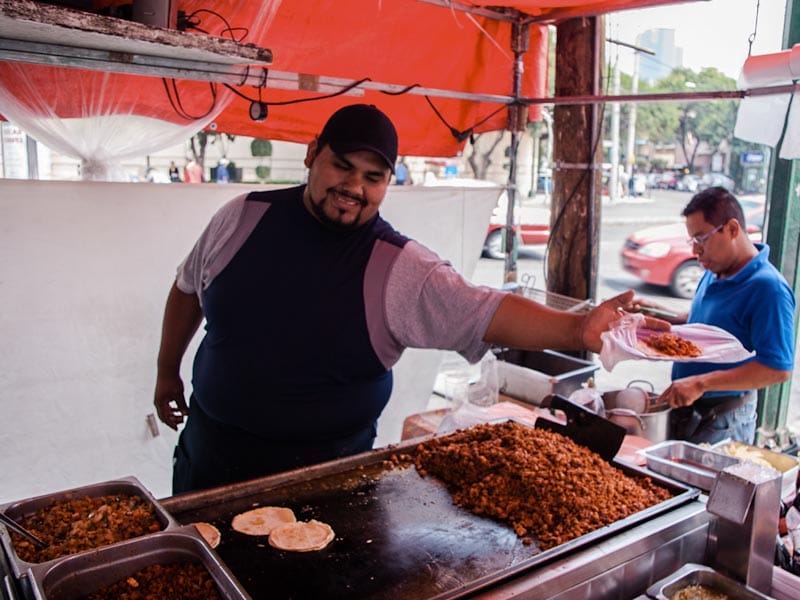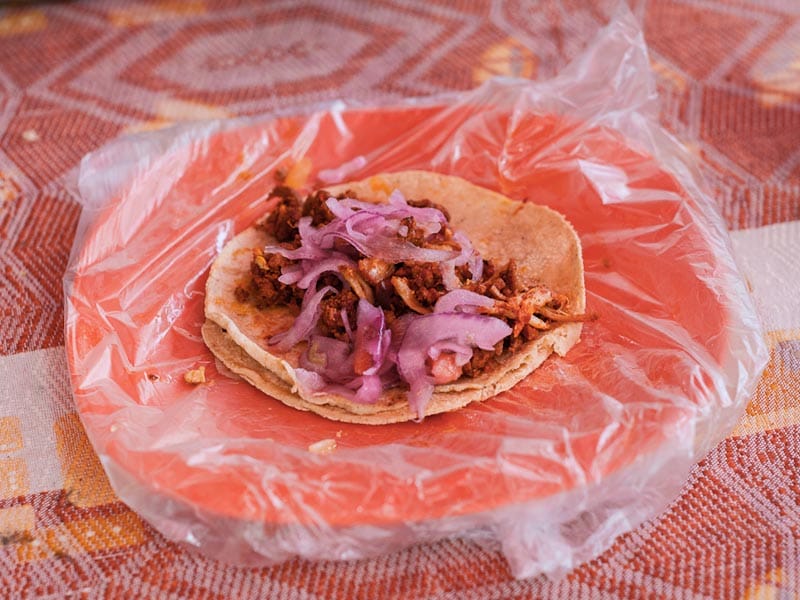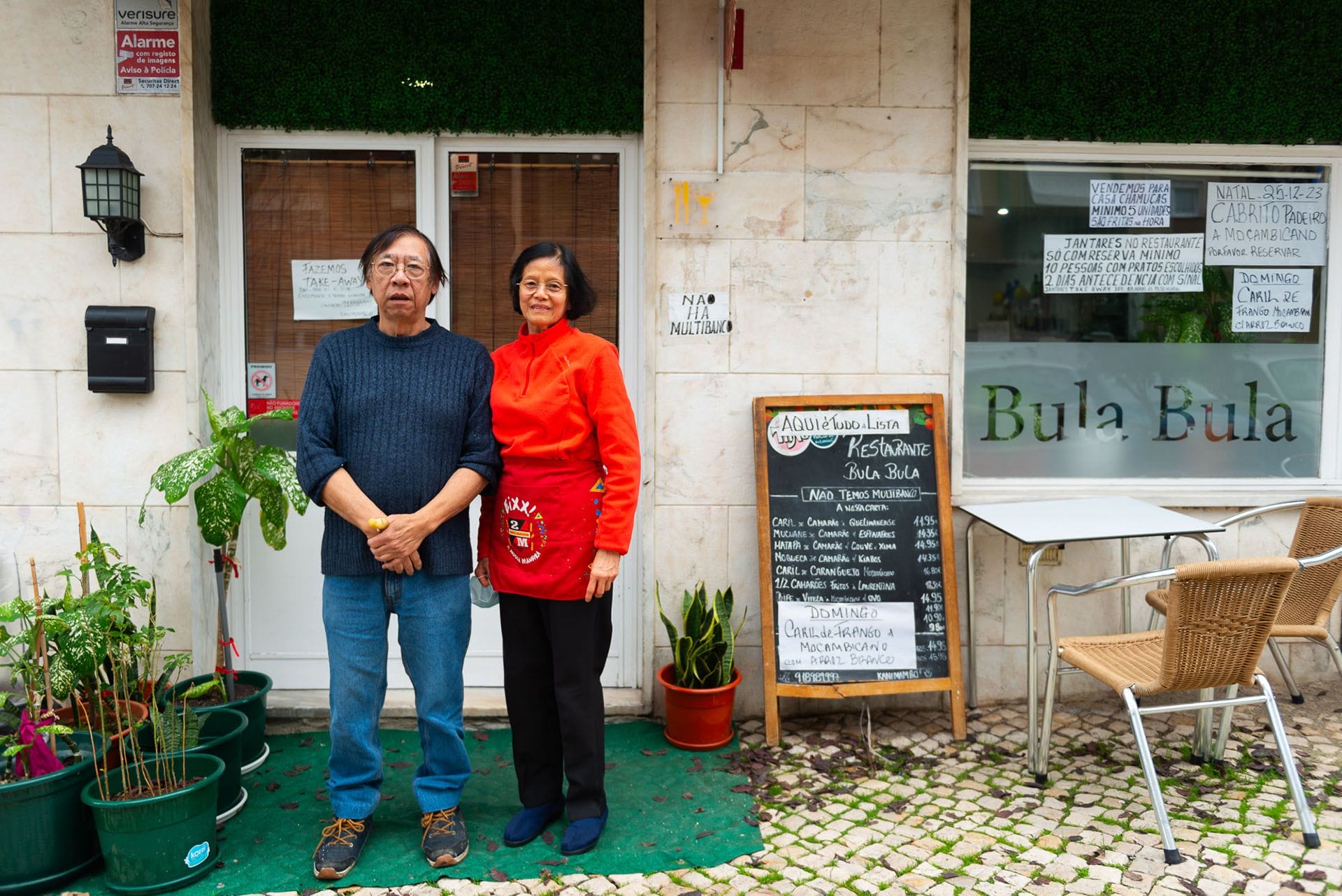Update: This spot is sadly no longer open.
Making mixiote takes some effort. On its home turf in Central Mexico, the dish is made by taking chicken, beef or mutton that is seasoned with pasilla and guajillo chili peppers as well as flavorings like thyme, cumin, bay leaves, oregano, onion and garlic, wrapping it in individual portions in maguey leaves and then slow-cooking the bundle in a pit, preferably overnight. But how about in Mexico City, a crowded metropolis where it’s not always possible to build a BBQ pit in the ground, or to obtain maguey leaves, which are both expensive and difficult to work with?
At Tacomix, a popular, family-run trio of street stands specializing in mixiotes, the owners have solved the problem by coming up with a new way to prepare the meat. “This is a family recipe handed down from my mom’s side. But we’ve made some changes to the recipe and the way we cook it over the years,” Marco Carmona, 31, the son of the founders of Tacomix, told us. Instead of in a pit, the Carmonas slow-cook their meat in large pots for some 12 hours over low heat, resulting in a flavor that Marco insists closely approximates the original version.

And we believe he’s right. At the original Tacomix location, in business in the same spot for 24 years, the menu consists simply of tacos filled with either mutton mixiote or bistec enchilado, a type of seasoned beef. (Other dishes, such as chicken and chorizo tacos, can be found at the other two locations.) But when both meats are so perfectly seasoned and flavorful, the menu really doesn’t need to be expanded. The tables at Tacomix are lined with buffet-style trays offering a variety of complimentary condiments to make the perfect taco: boiled and roasted chile de árbol salsas, beans, cooked nopales (cactus), sliced onions marinated in lime juice and habanero and manzano peppers – by far the hottest option. The tacos are good-sized; four to six are enough to satisfy most hungry customers. However, if you’re starving and want to try breaking the record of tacos eaten in one sitting at Tacomix – which currently stands at 24 – your meal, as well as your next, will be on the house.
The original eatery is located on the sidewalk of El Oro in Colonia Roma. On Saturdays, a tianguis is held on the same street, making the scene more colorful and full of life. Although the sidewalk is lined with food stands, Tacomix is easy to recognize for its neon sign, massive flat-screen TVs hung on the wall that forms the back of the eatery, and the large quantities of mutton and beef on the griddle. At the other end of the sidewalk, across from the griddle, an aguas frescas machine constantly pumps out jamaica, horchata and tamarindo-flavored aguas. As is typical of the street food scene in Mexico, hungry customers share tables in a communal dining experience.

From its original street stand, Tacomix has expanded over the years to three locations around the city, all managed by the Carmona family. They also cater small and large parties and have become so popular that they have even been featured on Mexican television. Like many small food businesses in Mexico, Tacomix is a family enterprise in which all the members, including grandparents and kids, participate. “When I was a kid my dad had to set up the small stand we owned at that time by himself. We didn’t have a griddle. We had a small charcoal grill that was hauled along with all the food and family in the car,” Marco recalls. “But thanks to our customers, we now have several locations. My sister and I have big plans for the future, which include selling franchises. My parents worked hard for a long time and now they are able to take their grandkids on vacation while my sister and I take care of things. I’m doing this for the kids. We want a better life for them.”
This work ethic seems to be benefiting everyone. Through their efforts, the Carmonas may be creating a better life for their children, but they have also been making things easier for local eaters, whose cravings for mixiote previously could have only been satisfied by taking a trip out of Mexico City.
 February 23, 2024 Bula Bula
February 23, 2024 Bula Bula
Mozambican, Portuguese and Cantonese – with a fair bit of Indian thrown in. On the […] Posted in Lisbon July 8, 2015 Baylan Pastanesi
July 8, 2015 Baylan Pastanesi
The roaring '20s: Flappers in the Pera Palas Hotel were dancing the can-can, Art Deco […] Posted in Istanbul February 27, 2020 Il Ristorantino dell’Avvocato
February 27, 2020 Il Ristorantino dell’Avvocato
In life, it’s never too late to try changing course. It’s not always possible, it’s not […] Posted in Naples
Published on August 23, 2013
Related stories
February 23, 2024
LisbonMozambican, Portuguese and Cantonese – with a fair bit of Indian thrown in. On the surface, it’s an utterly unlikely culinary mashup. But it makes perfect sense at Bula Bula, a restaurant on Lisbon’s northern outskirts. The husband-and-wife owners of Bula Bula, Ana Lee and Fernando Ho, are ethnic Chinese who can trace their ancestry…
July 8, 2015
IstanbulThe roaring '20s: Flappers in the Pera Palas Hotel were dancing the can-can, Art Deco was all the rage, the Turkish Republic was born. Hope, progress and newness double-stepped to the beat of Kemal Atatürk’s drum. This was the backdrop to which two Istanbul bakers, Filip and Yorgi, opened a whimsical chapter in the culinary…
February 27, 2020
NaplesIn life, it’s never too late to try changing course. It’s not always possible, it’s not always easy, but when you succeed, what satisfaction. Seventy-year-old Raffaele Cardillo, with his smiling face and white beard, can attest to that. After 20 years spent working as a lawyer, shuttling between courts and meetings with defendants, and puzzling…


















































































